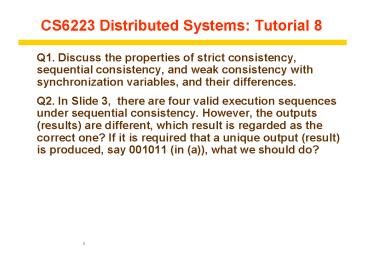CS6223 Distributed Systems: Tutorial 8 - PowerPoint PPT Presentation
1 / 14
Title:
CS6223 Distributed Systems: Tutorial 8
Description:
It is often argued that weak consistency models impose an extra burden for ... In such a consistency model, when a process performs an operation on an ordinary ... – PowerPoint PPT presentation
Number of Views:145
Avg rating:3.0/5.0
Title: CS6223 Distributed Systems: Tutorial 8
1
CS6223 Distributed Systems Tutorial 8
- Q1. Discuss the properties of strict consistency,
sequential consistency, and weak consistency with
synchronization variables, and their differences. - Q2. In Slide 3, there are four valid execution
sequences under sequential consistency. However,
the outputs (results) are different, which result
is regarded as the correct one? If it is required
that a unique output (result) is produced, say
001011 (in (a)), what we should do?
2
Sequential Consistency Examples
- Four valid execution sequences for the processes.
The vertical axis is time.
3
CS6223 Distributed Systems Tutorial 8
- Q3. Explain how replication in DNS takes place,
and why it actually works so well. - Q4. Suppose that there are two processes as
follows - Process P1 Process
P2 - a 1 b
1 - if (b0) kill (P2) if
(a0) kill (P1) - List all possible statement interleaving that
are allowed under sequential consistency memory. - Q5. It is often argued that weak consistency
models impose an extra burden for programmers. To
what extent is this statement actually true?
4
Tutorial 8 Q1 Ans.
- Q2 Ans.
- Strict consistency Any read on a data item x
returns a value corresponding to the result of
the most recent write on x. - The definition implicitly assumes the
existence of absolute global time, so that the
determination of most recent is unambiguous. - There is no notion of absolute global time in
DS. It is impossible to implement strict
consistency in DS.
5
Strict Consistency
- Behavior of two processes, operating on the same
data item. - (a) A strictly consistent store.
- (b) A store that is not strictly consistent.
6
Tutorial 8 Q1 Ans.
- Sequential consistency (Lamport, 1979) A data
store is said to be sequentially consistent if it
satisfies the following condition - The result of any execution is the same
as if the (read and write) operations by all
processes on the data store were executed in some
sequential order and the operations of each
individual process appear in this sequence in the
order specified by its program. - when processes run concurrently, possibly on
different machines, any interleaving of read and
write operations is acceptance behavior, but all
processes should see the same interleaving of
operations.
7
Sequential Consistency
- A sequentially consistent data store.
- A data store that is not sequentially consistent.
8
Tutorial 8 Q1 Ans.
- Weak consistency models using synchronization
variables, have the following three properties - (1) Accesses to synchronization variables
associated with a data store are sequentially
consistent - (2) No operation on a synchronization variable
is allowed to be performed until all previous
writes have been completed everywhere - (3) No read or write operation on data items
are allowed to be performed until all previous
operations to synchronization variables have been
performed.
9
Tutorial 8 Q1 Ans.
- In such a consistency model, when a process
performs an operation on an ordinary shared data
item (e.g., in critical region) no guarantees are
given about when they will be visible to other
processes. Only when an explicit synchronization
takes place, are changes propagated. Weak
consistency enforces (sequential) consistency on
a group of operations, using synchronization
variables as boundaries.
10
Weak Consistency
- A valid sequence of events for weak consistency.
- An invalid sequence for weak consistency.
11
Summary of Consistency Models
12
Tutorial 8 Q2
- Q3 Ans.
- All four outputs (results) are correct. In
practice, users are taught to program in such a
way that exact order of statement execution (in
interleaving) does not matter. That is, any
result from a valid interleaving should be
acceptable. When such an execution order is
essential, i.e., a unique interleaving is
required to produce a unique result,
synchronization operations (or semaphore etc)
should be used to enforce such an execution.
13
Tutorial 8 Q3 Q4 Ans.
- Q4 Ans. The basic idea is that name servers cache
previously looked up results. These results can
be kept in a cache for a long time, because DNS
makes the assumption that name-to-address
mappings do not change often. - Q5 Ans. The six statement interleavings are as
follows - (1) a1 if (b0) b1 if (a0)
- (2) a1 b1 if (a0) if (b0)
- (3) a1 b1 if (b0) if (a0)
- (4) b1 if (a0) a1 if (b0)
- (5) b1 a1 if (b0) if (a0)
- (6) b1 a1 if (a0) if (b0)
14
Tutorial 8 Q5 Ans.
- Q6 Ans.
- It really depends. Many programmers are used
to protect their shared data through
synchronization mechanisms such as locks or
transactions. The main idea is that they require
a coarser grain of concurrency than one offered
at the level of only read and write operations.
However, programmers do expect that operations on
synchronization variables adhere to sequential
consistency.































